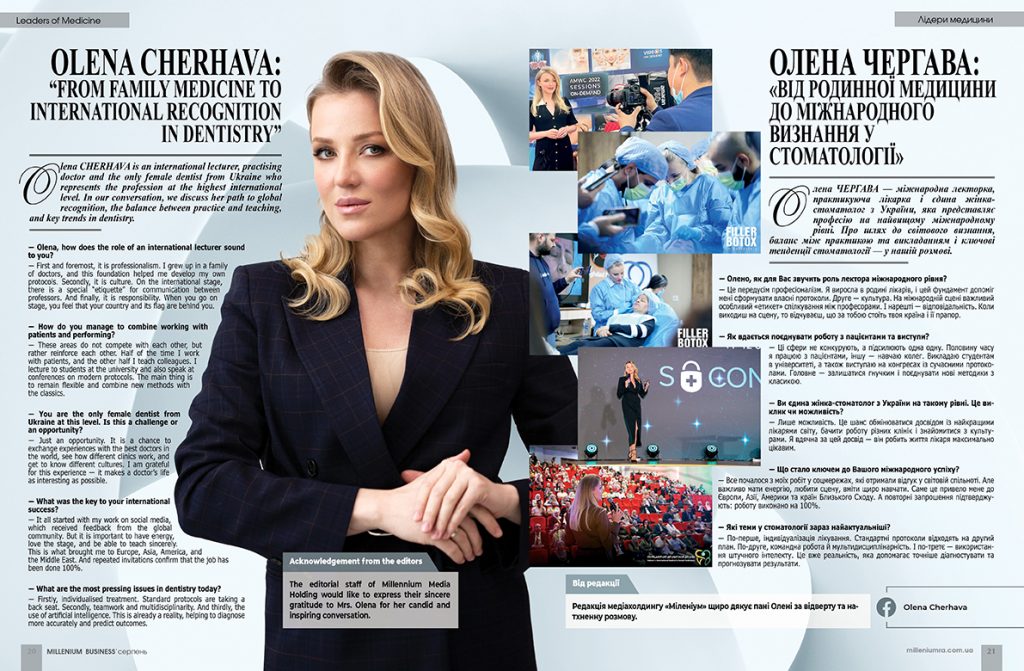Олена ЧЕРГАВА — міжнародна лекторка, практикуюча лікарка і єдина жінка-стоматолог з України, яка представляє професію на найвищому міжнародному рівні. Про шлях до світового визнання, баланс між практикою та викладанням і ключові тенденції стоматології — у нашій розмові.

— Олено, як для Вас звучить роль лектора міжнародного рівня?
— Це передусім професіоналізм. Я виросла в родині лікарів, і цей фундамент допоміг мені сформувати власні протоколи. Друге — культура. На міжнародній сцені важливий особливий «етикет» спілкування між професорами. І нарешті — відповідальність. Коли виходиш на сцену, то відчуваєш, що за тобою стоїть твоя країна і її прапор.
— Як вдається поєднувати роботу з пацієнтами та виступи?
— Ці сфери не конкурують, а підсилюють одна одну. Половину часу я працюю з пацієнтами, іншу — навчаю колег. Викладаю студентам в університеті, а також виступаю на конгресах із сучасними протоколами. Головне — залишатися гнучким і поєднувати нові методики з класикою.
— Ви єдина жінка-стоматолог з України на такому рівні. Це виклик чи можливість?
— Лише можливість. Це шанс обмінюватися досвідом із найкращими лікарями світу, бачити роботу різних клінік і знайомитися з культурами. Я вдячна за цей досвід — він робить життя лікаря максимально цікавим.
— Що стало ключем до Вашого міжнародного успіху?
— Все почалося з моїх робіт у соцмережах, які отримали відгук у світовій спільноті. Але важливо мати енергію, любити сцену, вміти щиро навчати. Саме це привело мене до Європи, Азії, Америки та країн Близького Сходу. А повторні запрошення підтверджують: роботу виконано на 100%.
— Які теми у стоматології зараз найактуальніші?
— По-перше, індивідуалізація лікування. Стандартні протоколи відходять на другий план. По-друге, командна робота й мультидисциплінарність. І по-третє — використання штучного інтелекту. Це вже реальність, яка допомагає точніше діагностувати та прогнозувати результати.
OLENA CHERHAVA:
“FROM FAMILY MEDICINE TO INTERNATIONAL RECOGNITION IN DENTISTRY”
Оlena CHERHAVA is an international lecturer, practising doctor and the only female dentist from Ukraine who represents the profession at the highest international level. In our conversation, we discuss her path to global recognition, the balance between practice and teaching, and key trends in dentistry.
— Olena, how does the role of an international lecturer sound to you?
— First and foremost, it is professionalism. I grew up in a family of doctors, and this foundation helped me develop my own protocols. Secondly, it is culture. On the international stage, there is a special “etiquette” for communication between professors. And finally, it is responsibility. When you go on stage, you feel that your country and its flag are behind you.
— How do you manage to combine working with patients and performing?
— These areas do not compete with each other, but rather reinforce each other. Half of the time I work with patients, and the other half I teach colleagues. I lecture to students at the university and also speak at conferences on modern protocols. The main thing is to remain flexible and combine new methods with the classics.
— You are the only female dentist from Ukraine at this level. Is this a challenge or an opportunity?
— Just an opportunity. It is a chance to exchange experiences with the best doctors in the world, see how different clinics work, and get to know different cultures. I am grateful for this experience — it makes a doctor’s life as interesting as possible.
— What was the key to your international success?
— It all started with my work on social media, which received feedback from the global community. But it is important to have energy, love the stage, and be able to teach sincerely. This is what brought me to Europe, Asia, America, and the Middle East. And repeated invitations confirm that the job has been done 100%.
— What are the most pressing issues in dentistry today?
— Firstly, individualised treatment. Standard protocols are taking a back seat. Secondly, teamwork and multidisciplinarity. And thirdly, the use of artificial intelligence. This is already a reality, helping to diagnose more accurately and predict outcomes.
